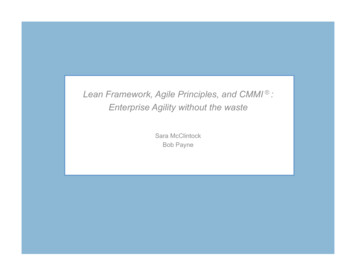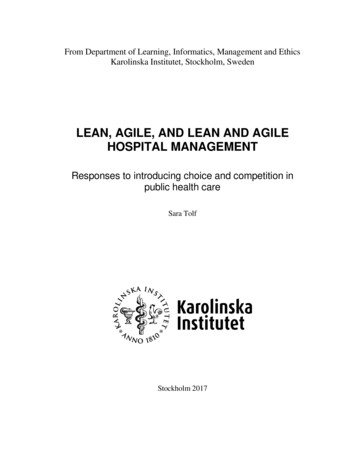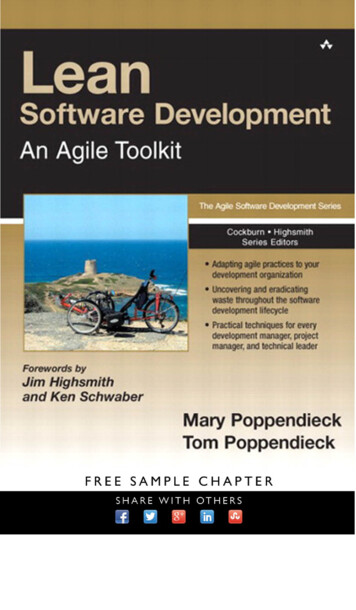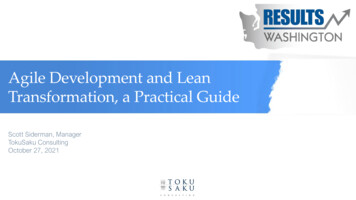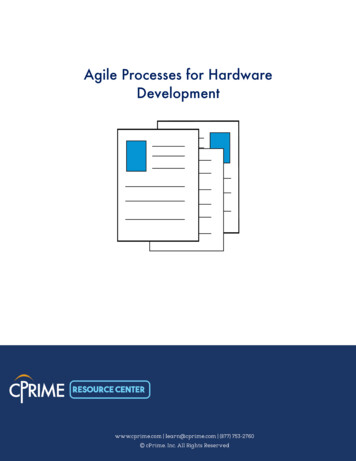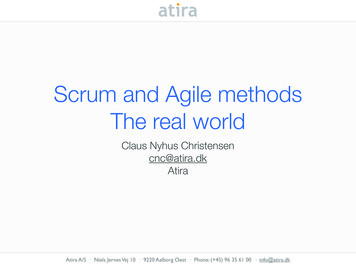
Transcription
SOFTWARE ENGIN E E R I N G / AG I L EAgile techniques have demonstrated immense potential for developing more effective, higher-quality software. However,scaling these techniques to the enterprise presents many challenges. The solution is to integrate the principles and practicesof Lean Software Development with Agile’s ideology and methods. By doing so, software organizations leverage Lean’spowerful capabilities for “optimizing the whole” and managing complex enterprise projects.S H A L L O W AYB E AV E RTROT TLEAN-AGILE SOFTWARE DEVELOPMENTA combined “Lean-Agile” approach can dramatically improve both developer productivity and the software’s business value.In this book, three expert Lean software consultants draw from their unparalleled experience to gather all the insights,knowledge, and new skills you need to succeed with Lean-Agile development.Lean-Agile Software Development shows how to extend Scrum processes with an Enterprise view based on Lean principles.The authors present crucial technical insight into emergent design, and demonstrate how to apply it to make iterativedevelopment more effective. They also identify several common development “anti-patterns” that can work against yourgoals, and they offer actionable, proven alternatives.Lean-Agile Software Development shows how toTransition to Lean Software Development quickly and successfullyManage the initiation of product enhancementsHelp project managers work together to manage product portfolios more effectivelyManage dependencies across the software development organization and with its partners and colleaguesIntegrate development and QA roles to improve quality and eliminate wasteDetermine best practices for different software development teamsThe book’s companion Web site, www.netobjectives.com/lasd, provides updates, links to related materials, and supportfor discussions of the book’s content.About the AuthorsAlan Shalloway, founder and CEO of Net Objectives, is a renowned thought leader, trainer, and coach in Lean SoftwareDevelopment, Kanban, and Agile design patterns. Guy Beaver, VP of Enterprise Engagements and senior consultant/coachwith Net Objectives, has an extensive track record of success in Lean-Agile implementations in large, midsize, and start-uporganizations. James Trott, senior consultant for Net Objectives, has used object- and pattern-based analysis techniquesthroughout twenty years in knowledge management and knowledge engineering. Shalloway and Trott coauthored DesignPatterns Explained (Addison-Wesley, over design by Chuti PrasertsithCover photo by John Wang /Getty ImagesISBN-13: FTWARE DEVELOPMENT LEAN-AGILESOFTWAREDEVELOPMENTAchieving Enterprise AgilityA L A N S H A L L O W AYG U Y B E AV E RJAMES R. TROT T5 3 9 9 9Text printed on recycled paper9780321 532893 39.99 U.S./ 47.99 CANADALean-Agile Series
Illustrations by Andrea Chartier BainMany of the designations used by manufacturers and sellers to distinguish their products are claimedas trademarks. Where those designations appear in this book, and the publisher was aware of a trademark claim, the designations have been printed with initial capital letters or in all capitals.The authors and publisher have taken care in the preparation of this book, but make no expressed orimplied warranty of any kind and assume no responsibility for errors or omissions. No liability isassumed for incidental or consequential damages in connection with or arising out of the use of theinformation or programs contained herein.The publisher offers excellent discounts on this book when ordered in quantity for bulk purchases orspecial sales, which may include electronic versions and/or custom covers and content particular toyour business, training goals, marketing focus, and branding interests. For more information, pleasecontact:U.S. Corporate and Government Sales(800) 382-3419corpsales@pearsontechgroup.comFor sales outside the United States please contact:International Salesinternational@pearsoned.comVisit us on the Web: informit.com/netobjectivesLibrary of Congress Cataloging-in-Publication DataShalloway, Alan.Lean-agile software development : achieving enterprise agility / Alan Shalloway, Guy Beaver, JamesR. Trott.p. cm.Includes bibliographical references and index.ISBN 0-321-53289-9 (pbk. : alk. paper) 1. Agile software development. I. Beaver, Guy. II. Trott,James. III. Title.QA76.76.D47S47 2009005.1—dc222009032621Copyright 2010 Pearson Education, Inc.All rights reserved. Printed in the United States of America. This publication is protected by copyright,and permission must be obtained from the publisher prior to any prohibited reproduction, storage ina retrieval system, or transmission in any form or by any means, electronic, mechanical, photocopying,recording, or likewise. For information regarding permissions, write to:Pearson Education, IncRights and Contracts Department501 Boylston Street, Suite 900Boston, MA 02116Fax: (617) 671-3447ISBN-13: 978-0-321-53289-3ISBN-10:0-321-53289-9Text printed in the United States on recycled paper at Courier in Stoughton, Massachusetts.First printing, October 2009
Series ForewordThe Net Objectives ProductDevelopment SeriesAlan Shalloway, CEO, Net ObjectivesIf you are like me, you will just skim this foreword for the series andmove on, figuring there is nothing of substance here. That would be amistake. Unless you have read this foreword in another book in the series,please take a moment with me at the outset of this book (if you’ve alreadyread a foreword from another book, please skip a couple of pages to ThisBook’s Role in the Series).I want you to consider with me a tale that most people know but don’toften think about. That tale illustrates what is ailing this industry. And itsets the context for why we wrote the Net Objectives Product DevelopmentSeries and this particular book.I have been doing software development since 1970. To me, it is justas fresh today as it was four decades ago. It is a never-ending source offascination to me to contemplate how to do something better, and it is anever-ending source of humility to confront how limited my abilitiestruly are. I love it.Throughout my career, I have also been interested in other industries,especially engineering and construction. Now, engineering and construction have suffered some spectacular failures: the Leaning Tower of Pisa,the Tacoma Narrows Bridge, the Hubble telescope. In its infancy, engineers knew little about the forces at work around them. Mostly, engineerstried to improve practices and to learn what they could from failures. Ittook a long time—centuries—before they acquired a solid understandingabout how to do things.No one would build a bridge today without taking into account longestablished bridge-building practices (factoring in stress, compression, andthe like) but software developers get away with writing code based on“what they like” every day, with little or no complaint from their peers.Why do we work this way?xvii
xviiiSeries Foreword The Net Objectives Product Development SeriesBut this is only part of the story. Ironically, much of the rest is relatedto why we call this the “Net Objectives Product Development Series.” TheNet Objectives part is pretty obvious. All of the books in this series werewritten either by Net Objectives staff or by those whose views are consistent with ours. Why Product Development? Because when building software, it is always important to remember that software development isreally product development.By itself, software has little inherent value. Its value comes when itenables delivery of products and services. Therefore, it is more useful tothink of software development as part of product development—the setof activities we use to discover and create products that meet the needsof customers while advancing the strategic goals of the company.Mary and Tom Poppendieck, in their excellent book, Implementing LeanSoftware Development: From Concept to Cash (2006), note:It is the product, the activity, the process in which software isembedded that is the real product under development. Thesoftware development is just a subset of the overall productdevelopment process. So in a very real sense, we can call software development a subset of product development. And thus,if we want to understand lean software development, wewould do well to discover what constitutes excellent productdevelopment.In other words, software in itself isn’t important. It is the value that itcontributes—to the business, to the consumer, to the user—that is important. When developing software, we must always remember to look towhat value is being added by our work. At some level, we all know this.But so often organizational “silos” work against us, keeping us fromworking together, from focusing on efforts that create value.The best—and perhaps only—way to achieve effective product development across an organization is a well-thought-out combination of Leanprinciples to guide the enterprise, Agile practices to manage teams, andtechnical skills (test-driven development, design patterns). That is themotivation for the Net Objectives Product Development Series.Too long, this industry has suffered from a seemingly endless swing ofthe pendulum from no process to too much process and then back to noprocess: from heavyweight methods focused on enterprise control to disciplined teams focused on the project at hand. The time has come formanagement and individuals to work together to maximize the produc-
This Book’s Role in the Seriestion of business value across the enterprise. We believe Lean principlescan guide us in this.Lean principles tell us to look at the systems in which we work andthen relentlessly improve them in order to increase our speed and quality(which will drive down our cost). This requires1. Business to select the areas of software development that willreturn the greatest value2. Teams to own their systems and continuously improve them3. Management to train and support their teams to do this4. An appreciation for what constitutes quality workIt may seem that we are very far from achieving this in the softwaredevelopment industry, but the potential is definitely there. Lean principles help with the first three and the understanding of technicalprogramming and design has matured far enough to help us with thefourth.As we improve our existing analysis and coding approaches with thediscipline, mindset, skills, and focus on value that Lean, Agile, patterns,and test-driven development teach us, we will help elevate softwaredevelopment from being merely a craft into a true profession. We havethe knowledge required to do this; what we need is a new attitude.The Net Objectives Product Development Series aims to develop thisattitude. Our goal is to help unite management and individuals in workefforts that “optimize the whole”: The whole organization Integrating enterprise, team, and individuals to work best together. The whole product Not just its development, but also its maintenance and integration. The whole of time Not just now, but in the future. We wantsustainable ROI from our effort.This Book’s Role in the SeriesWhile Scott Bain’s Emergent Design: The Evolutionary Nature of the SoftwareProfession dealt with how to raise the bar in technical practices, this bookis about how to raise the bar in product and project management. Bothxix
xxSeries Foreword The Net Objectives Product Development Seriesbooks, as I suspect all books in the series will be, are based on the beliefthat there are laws (rules) that must be followed to be effective and efficient.As Agile has matured, we’re finding it useful to go beyond the meremandate of building in stages and having teams solve their own problems.While both are sage advice, more is needed as our products become morecomplex. Management needs to become more intimately involved insolving the problems teams face. And although the development teamsare the ones who actually deliver the value, they are not empowered tosolve the organizational and cultural problems that get in their way.We believe that Lean thinking provides a new way for managementand teams to work together. We further believe that the next generationof Agile methods will be those that promote this cooperative effort insteadof being neutral at best and negative at worst. This book is therefore aboutraising software development closer to a professional level throughoutthe organization.The End of an Era, the Beginning of a New EraI believe the software industry is at a crisis point. The industry is continually expanding and becoming a more important part of our everydaylives. But software development groups are facing dire problems. Decayingcode is becoming more problematic. An overloaded workforce seems tohave no end in sight. Although Agile methods have brought greatimprovements to many teams, more is needed. By creating a true software profession, combined with the guidance of Lean principles andincorporating Agile practices, we believe we can help uncover theanswers.I hope you find this book series to be a worthy guide.
PrefaceThis book was born from need and from knowledge. The need is toexpand the knowledge base of software development in both themanagement and process worlds so as to create a new base. IntegratingAgile has transformed the software-development process in less than adecade. Although its mandate applies to all of software development, itsfocus typically has been on the teams directly involved in the development of software and on the projects they work on. As Agile has begunto transcend the early-adopter phase and move on to the early-majorityphase, there are new challenges to address as Agile is applied to quitedifferent situations. Larger organizations are attempting to adopt Agile for the first time. Organizations that are already using Agile are expanding the scaleof their adoption. Organizations that are somewhat dysfunctional are starting to adoptAgile.Extending Agile to these new situations creates the need for a betterunderstanding of what Agile is and a broader set of tools to apply Agile.These two issues are surprisingly tightly related. Many Agile early adopters have learned from any number of excellent books that present a setof practices, mostly oriented around the team. Unfortunately, few of thesebooks explain why Agile works. Rather, they are filled with excellentpractices that embody Agile’s fundamental belief systems while providinga set of practices that work at the team level in many situations.xxi
xxiiPrefaceThe wider adoption of Agility demands more. There is now a need fora greater scope of knowledge as well as an explanation of why the practices work. While almost all Agile methods sprang up independently ofLean thinking, Lean thinking provides insight into why Agile works. Thisis why most of Agile’s methods are compatible with Lean. True knowledge is realized when one can apply principles and practices together toform solid understanding. We use the term “Lean-Agile” for the approachdescribed in this book because it represents our contention that for Agileto work most effectively, it must be applied within the context of Lean.This book fills the need both to understand why Agility works as wellas to expand its base of principles and practices in order to apply it to theenterprise. It builds on the work of others, most particularly, those ofDavid Anderson, Kent Beck, Jane Cleland-Huang, Alistair Cockburn, JimCoplien, Ward Cunningham, W. Edwards Deming, Mark Denne, RonJeffries, Daniel Jones, Michael Kennedy, Corey Ladas, David Mann, BobMartin, Rick Mugridge, Taichi Ohno, Mary Poppendieck, TomPoppendieck, Don Reinertsen, Peter Scholtes, Ken Schwaber, JeffSutherland, James Womack, Alan Ward, and so many others. This blendof Lean, Agile, XP, Scrum, and other disciplines creates the synergisticblend essential to providing answers, both deep and broad, that the enterprise requires.I want to give particular thanks to a few people who have helped uspersonally in our endeavors. Mary and Tom Poppendieck for helping me get my start in Leantraining. Both have been invaluable to my personal developmentwith their combination of suggestions for improvement tailored byrespect and compassion. Don Reinertsen for his kindness and encouragement, not to mention the amazing amount of knowledge that his books have conveyed to the community. David Anderson for his outspokenness and out-of-the box thinking.He’s been an inspiration to go further in my thinking than I havetypically dared. Ward Cunningham. I know few people smarter than Ward, balanced with such an unassuming nature. His wisdom and mannerhave been invaluable. Our own Alan Chedalawada, who may not have contributed to thewriting in this book, but whose ideas formed the basis for much of
Prefacewhat we are presenting here that is new. Many of these ideas hefirst manifested in the real world. Our own Amir Kolsky and Ken Pugh for insights into the role ofacceptance test-driven development.While it may seem odd for one author to acknowledge another, I mustacknowledge Jim Trott—both a close associate and one of my dearestfriends. Without his encouragement, hard work, and efforts on keepingme focused, this book may not have happened.Alan ShallowayCEO, Net ObjectivesAchieving Enterprise and Team Agilityxxiii
Introduction“We can’t solve problems by using the same kind of thinking we used when wecreated them.” —Albert EinsteinOne of the goals of this book is to give you a better perspective onLean and Agile and how to use them in software development. Thisrequires an understanding of the roots of Agility, the software development “pendulum,” and the importance of paradigms and practices and ofbeing pragmatic. Lean offers a way forward.This book takes the reader beyond Agile’s standard practices by teaching how to incorporate Lean thinking into software development.Although Agile, as it is usually practiced, is effective at the team level, itgives little guidance on how it fits at the enterprise level. This is somewhatfor historical reasons, as you will see. Lean-Agile is an approach to Agilesoftware development using Lean principles and practices for guidance.You can think of Agile in one of two ways: as a set of values and beliefsthat leave it to the practitioners to decide how to apply them or as a setof practices that are suggested to manifest good results. Practitioners typically use a combination of both, believing the mandate of the AgileManifesto and then using either Scrum1 or eXtreme Programming2 (orsome of each) as the basis for their methods. The challenge with thisapproach is two-fold—one resulting from the roots of Agility and theother from the lack of a theoretical foundation for the Agile practicesthemselves—as we will discuss later.1. Scrum is a popular Agile process created by Jeff Sutherland and Ken Schwaber. It is commonly used at the team level and is characterized by self-organizing, cross-functional teamsdoing iterative development in what are called sprints.2. eXtreme Programming is an iterative development process for teams centered around severalengineering practices. The most common of these is test-driven development, paired programming, and continuous integration.xxix
xxxIntroductionHow This Book Will Help YouThis book aims to change how you look at software development. Doingso will enable you to solve seemingly intransigent problems with muchless effort than you might have thought possible. One of our guidingprinciples is that we need to drive from business value: Deliver the value(software) that will provide the greatest return to the business by providing the greatest value to the business’s customers. For an IT developmentgroup, this could mean either internal or external customers.Together, we will explore what software development actually is andhow it must be managed. We will investigate ways to help our customersthrough the process of selecting what work to accomplish through development, deployment, and, ultimately, ongoing support and enhancement.We will drive from principles throughout the book and provide a goodmany that you can apply in Lean Software Development. This book willnot give you all the answers; instead, it will help direct your thinking soyou can create answers that will work for you in your company, in yoursituation, for your customers, and with your products.The Roots of AgilityThe development of the Agile Manifesto (Beck et al. 2001) was a breakthrough event for the software industry. The manifesto, shown in FigureI.1, and its Twelve Principles, shown in Figure I.2, describe the essentialideology that underpins Agile software development.The Software Development PendulumThe Manifesto is a strong statement. It is consistent with the intentions ofmost people in the software development industry. But it says that wemust develop in a way that is different from the ways we have often triedin the past. It stands in opposition to the myth that the way to create quality, sustainable software is to conceive large plans and then use commandand-control management3 to realize them. When it was written, the AgileManifesto presented a great opportunity for exploring new, better ways of3. Apologies to military experts who properly use this term to mean vision at the top withimplementation at the bottom. We’re using this term in the way most people interpret it—top-level people telling lower-level people how to get their job done.
IntroductionManifesto for Agile Software Development4We are uncovering better ways of developing software by doing it and helping othersdo it. Through this work we have come to value:Individuals and interactionsWorking softwareCustomer collaborationResponding to changeoveroveroveroverprocesses and toolscomprehensive documentationcontract negotiationfollowing a planThat is, while there is value in the items on the right, we value the items on the left more.Figure I.1Manifesto for Agile Software DevelopmentPrinciples behind the Agile ManifestoWe follow these principles: Our highest priority is to satisfy the customer through early and continuous deliveryof valuable software. Welcome changing requirements, even late in development. Agile processes harnesschange for the customer’s competitive advantage. Deliver working software frequently, from a couple of weeks to a couple of months,with a preference to the shorter timescale. Business people and developers must work together daily throughout the project. Build projects around motivated individuals. Give them the environment and supportthey need, and trust them to get the job done. The most efficient and effective method of conveying information to and within adevelopment team is face-to-face conversation. Working software is the primary measure of progress. Agile processes promote sustainable development. The sponsors, developers, andusers should be able to maintain a constant pace indefinitely. Continuous attention to technical excellence and good design enhances Agility. Simplicity—the art of maximizing the amount of work not done—is essential. The best architectures, requirements, and designs emerge from self-organizingteams. At regular intervals, the team reflects on how to become more effective, then tunesand adjusts its behavior accordingly.Figure I.2Twelve Principles behind the Agile Manifesto4. Copyright 2001 Kent Beck, Mike Beedle, Arie van Bennekum, Alistair Cockburn, WardCunningham, Martin Fowler, James Grenning, Jim Highsmith, Andrew Hunt, Ron Jeffries,Jon Kern, Brian Marick, Robert C. Martin, Steve Mellor, Ken Schwaber, Jeff Sutherland,and Dave Thomas; this declaration may be freely copied in any form, but only in itsentirety through this notice.xxxi
xxxiiIntroductiondeveloping software. Unfortunately, it also left a huge hole. It did notattempt to describe how to achieve the promise.This lack of instructions is not a shortcoming of the Agile Manifesto.The Manifesto’s purpose was to create a vision for a better way to developsoftware. It is instructive to look at the Manifesto in its historical context.During the decades preceding the Manifesto, the principles of andapproaches to software management swung like a pendulum, betweenfree-form and command-and-control, from little process to too muchprocess. Each was responding to the challenges of the other.In the 1960s, several large system failures demonstrated the need forboth better engineering methods and better processes. Certainly, softwaredevelopment during this time was not an ad-hoc affair, but the industrywas new and there was little experience with large-scale systems. In the1970s, the idea of software as “engineering” surfaced. We began to usestructured analysis and design, top-down programming, and structuredprogramming (goto statements were considered bad form). Notably, theWaterfall model emerged. The industry was growing up, and standardpractices for design, programming, and management arose. By the 1980s,PCs and fourth-generation languages enabled small projects to flourish.Small teams produced much more software than large teams did.Prototyping was popular. Speed was king. If you were the first, you werethe best.But quality often suffered. Speed to entry was so important that aproduct’s sustainability was often ignored. This led to different kinds offailures. Since it was easy for anyone to enter the market, the competitiveedge of getting in first was lost if the product lacked quality. Failures inthis era triggered an upsurge in rigorous process. The sense was that if wecan’t do it ad hoc, then we’d better control it.Tick tock. Tick tock. The pendulum continued to swing. Maybe evenfaster.The 1990s brought us the Capability Maturity Model (CMM). Y2Kdominated the last few years of the decade, emphasizing the need forplanning ahead. But the ’90s also brought us the Internet, which againenabled small teams to have great impact. The dot-com boom broughtrapid software development. Again, a proliferation of small teams foundinitial success but subsequently had difficulty maintaining the softwarethat they had developed.Now, the twenty-first century has given rise to Agility—small teamsworking with customers to develop software quickly. There have beenmany successes and there have been many failures.
IntroductionAnd the pendulum continues to swing. What can we do to stop it? Orcan we at least find a balance?The Agile Manifesto was an attempt to find such balance. Let’s respectour teams. Let’s respect our customers. Let’s work with the business.Process can be good, but process that doesn’t help a team get its job doneis not.Unfortunately, the world is messy and the promise of the Manifestohas not been entirely realized. The Manifesto itself showed the potential,but it did not provide a means to stop the pendulum. In fact, it has beenused to justify letting teams rule. We have mostly lost the enterprise view,because that view seems to lead right back down the path of commandand-control management. If the choice is between that and using teamswith Agility, then abandoning command-and-control seems reasonable.It is not either-or. There is a way to balance command-and-controlwith the need for effective teams. Lean provides the way. To see why, wemust first examine the beliefs, principles, and paradigms on which webuild our thinking.Principles and ParadigmsA principle is a comprehensive and fundamental law, doctrine, or assumption. Principles may exist at the level of the individual, may be held by acommunity, or may even apply universally. For example, individual principles may relate to one’s integrity or one’s way of living. A communalset of principles might include moral or religious beliefs or a set of beliefsthat the community accepts as the true way to be living. Universal principles are those that apply everywhere—beyond the effect of the beliefsof any set of individuals. Perhaps we should actually call these laws of theuniverse. Principles are often stated in the form of guidance since thereis often a corresponding principle (law) that should be followed. Forexample, one of the best known Lean principles is “eliminate waste.”That’s not a law as much as it is something you should do, as a rule.A paradigm is a combination of assumptions, values, beliefs, and practices that define how to view reality, how to look at a situation. It is aworldview that characterizes what is true. Paradigms tend to last a longtime (consider how long people believed the earth was the center of theuniverse). Paradigms are shared by a particular community or group ofpeople. In the software world, Waterfall, Scrum, and Lean-Agile each havetheir own paradigms, or way of looking at how to best build software.xxxiii
xxxivIntroductionSince a paradigm defines what is real and true for someone, changingone’s paradigm is quite difficult. It requires the individuals and their community to grapple with the underlying assumptions, values, and beliefsand assess whether the paradigm actually squares with what is indeed“real” or whether some shift is required.The paradigms we hold constrain what we consider possible and shapewhat we do. Unexamined paradigms can therefore be very limiting.A Pragmatic ApproachSoftware development professionals are pragmatists (pragmatism is partof our worldview). We favor what works over what is represented astheoretically “correct.” It is not that theory is bad, but theory must begrounded in real work if we are going to embrace it.With that in mind, we would like to suggest taking a pragmaticapproach to evaluating the essential paradigms we, as software developers, hold. That approach is to use the scientific method in whatever wedo: Propose a hypothesis and then run an experiment to validate or invalidate it. If the experiment supports the hy
LEAN-AGILE SOFTWARE DEVELOPMENT scaling these techniques to the enterprise presents many challenges. The solution is to integrate the principles and practices of Lean Software Development with Agile’s ideology and methods. By doing so, software organizations leverage Lean’s powerful
